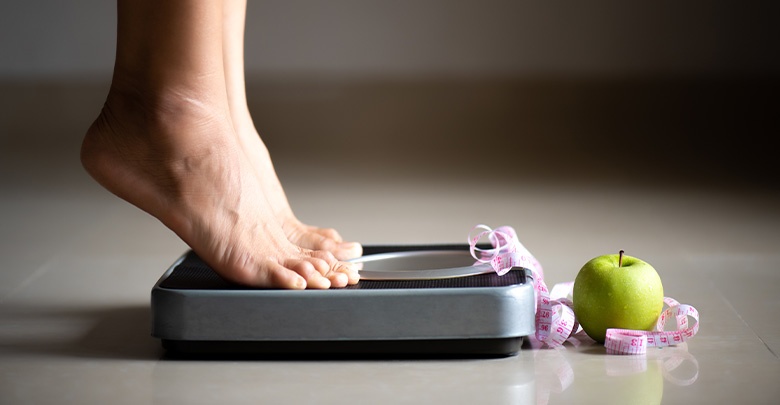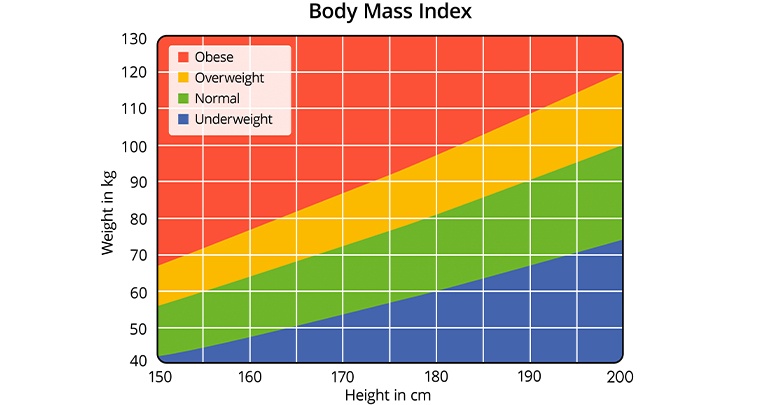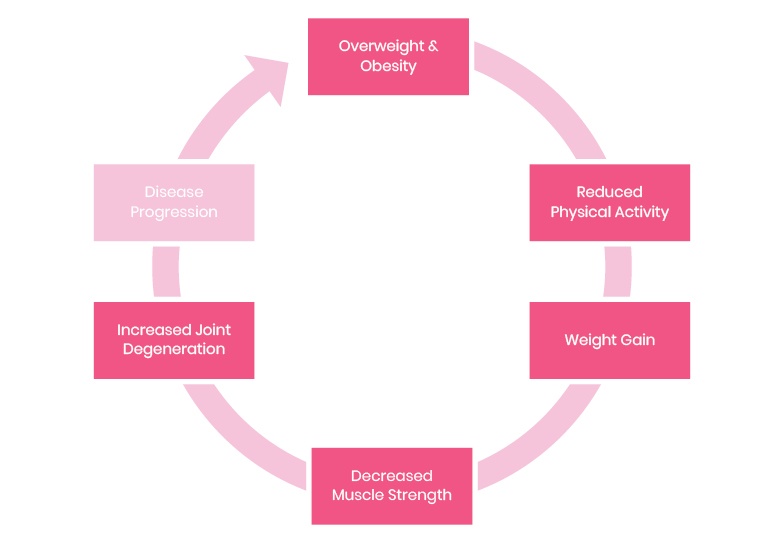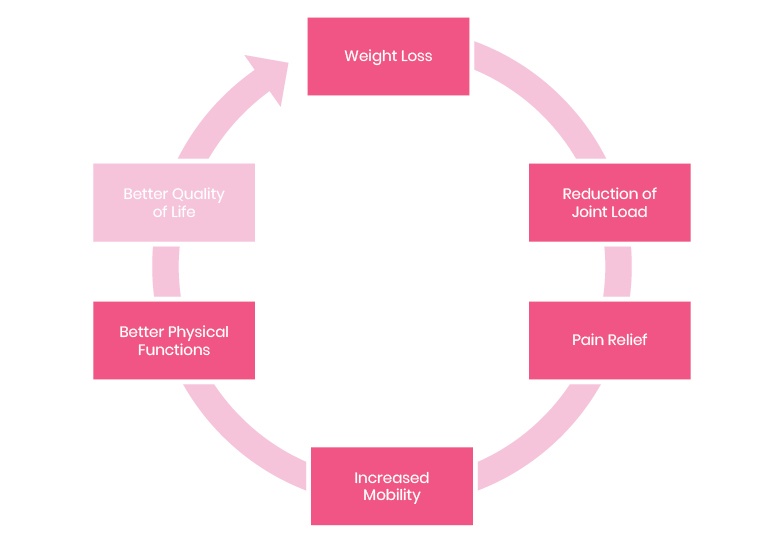Motivation! Weight Loss is Miraculous for those with Osteoarthritis
Osteoarthritis (OA) patients are often told to lose weight, in order to support their physical and medical treatments. If you need motivation to lose weight, then keep reading...

Osteoarthritis (OA) patients are often told to lose weight, in order to support their physical and medical treatments. If you need motivation to lose weight, then keep reading to find out why weight loss is so important, and also the best way to lose weight.
USE the OMH exclusive code "HEALTH15" to Save 15%Being obese or overweight are the two most important risk factors associated with the advancement of osteoarthritis. There are almost no treatment options for osteoarthritis where the effectiveness of the treatment is not negatively impacted by being overweight or obese.
Obese vs overweight? How to calculate your BMI
Obesity versus being overweight are most easily defined by the Body Mass Index (BMI). The Body Mass Index is the simplest way to calculate body fat, based on height and weight, and it is calculated the same for adult men and women alike.
If you would like to estimate your BMI you can use this BMI chart shown below, however the most accurate measurements need to be done by a healthcare professional.

You could also enter your age, height and weight into this calculator. Although slightly different for women and men, in general obesity is defined by a BMI of over 30, and being overweight is defined by a BMI of between 25 – 29.9.
The prevalence of obesity and being overweight has nearly doubled since 1980. Around 475 million adults worldwide are now estimated to be obese and a further 1 billion are considered to be overweight. Obese and overweight adults, among the older age groups, have risen to a prevalence of 20 – 30% in Europe and 35% in the United States.
The impact of obesity or being overweight on osteoarthritis
It is highly likely that there is very strong link between the increasing numbers of people now classified as being overweight or obese, and the rising numbers of people being diagnosed with osteoarthritis every year. OA diagnosis is rising by 1% per year, and currently 35% of people over 65 suffer from osteoarthritis.
Obesity is the most acknowledged risk factor for developing osteoarthritis, and is also the biggest factor in determining the deterioration of the condition.
It is also well known that obesity and being overweight negatively influence the deterioration of joints in osteoarthritis. Studies have shown that every 10 pounds of weight gain leads to a 36% increase in the risk of knee osteoarthritis. Furthermore, body weight seems to influence the severity of the osteoarthritis as well. Obese patients have a higher incidence of more severe joint degeneration, when compared with normal weight individuals. Other investigations have revealed a strong association between increased BMI and the need for hip and knee replacements.
The vicious cycle of being obese or overweight combined with osteoarthritis
Being obese or overweight, as well as having osteoarthritis causes a reduction in patients´ mobility. These two factors combined, lead to a vicious negative cycle of events:

This negative cycle of events is basically the reason why the incidence of being overweight or obese correlates so strongly with the incidence of osteoarthritis. It is obvious that this cycle has to be stopped in order to regain mobility and improve osteoarthritis symptoms. This is why physiotherapists, medical doctors and surgeons will all strongly recommend weight loss prior to, or during any osteoarthritis treatment.
Need motivation to lose weight? Weight loss can prevent the progression of osteoarthritis

There are numerous studies reporting on significantly improved clinical outcomes related to osteoarthritis, in patients who have lost weight. One of the most famous investigations is the Framingham study, which assessed over 1.800 adults over a time period of 35 years, in order to study the incidence and progression of osteoarthritis. This study showed that a 5.1 kg reduction in weight over a 10-year period decreased the likelihood of women developing symptoms of knee osteoarthritis by 50%.
Interestingly, the weight loss was associated with significant reduction of osteoarthritis risk in individuals with high baseline BMI > 25 (overweight) but not in those with BMI < 25 (normal weight).
Weight loss reduces the joint load
The most important reason for the strong correlation between weight loss and decreased osteoarthritis risk is the reduced joint load.
In a study performed in 2005, researchers estimated that every pound of weight loss in overweight and obese older patients with knee osteoarthritis resulted in a fourfold reduction in the load exerted on the knee per step. This is highly significance during daily activities and this difference in joint load is extremely meaningful clinically as well.


After only 5% weight loss in obese or overweight osteoarthritis sufferers, patients experienced relief from symptoms
An extremely good motivation to lose weight is due to the fact that weight loss can lead to the relief of many symptoms of osteoarthritis. The most important being pain relief. Both decreasing body weight as well as increasing physical activity are crucial steps, which lead to significant pain relief in knee osteoarthritis.
In a recent cohort study, data from over 1400 individuals with symptomatic knee osteoarthritis was evaluated. The data showed a correlation between changes in body weight and in self-reported pain, measured by scientifically validated pain scores. Even a 5% loss of body weight has been shown to provide pain relief in obese patients with osteoarthritis. However, most of the studies suggest that the optimal goal should be a decrease in body weight of at least 10%, in order to achieve significant reduction of pain symptoms. This is also the guideline for the treatment of overweight and obese adults by the NIH, which recommends an initial weight loss of 10% in obese individuals.

Weight loss and pain relief lead to further positive results – increased mobility and physical functioning in patients with osteoarthritis
Very importantly, pain reduction through weight loss also leads to increased mobility and improved physical functioning, which causes a positive cycle of events this time. Furthermore, quality of life as well as satisfaction with body function and appearance is also significantly improved after weight loss and pain relief.

Tips to lose weight
Recommendation for weight loss and physical activities for patients who are overweight or obese and have osteoarthritis
Many different scientific organizations all agree that weight loss by reduced calorie intake, together with increased regular physical activity are the recommended approach for osteoarthritis patients who are overweight or obese.
Weight loss by calorie restriction for osteoarthritis patients
There are many good calorie calculators and apps which are useful to know how many calories you are actually consuming every day. Most weight loss is through consuming less food, and only a small amount of weight loss is through exercise.
The NIH guidelines recommend a calorie intake of 300 – 500 kcal less per day for overweight people, and a calorie deficit of 500 – 1000 kcal per day for obese patients with osteoarthritis for a period of at least 6 months. These respective calorie cuts will lead to a moderate healthy weight loss of 250 – 500 grams per week, or a more rapid weight loss of 500 – 1000 grams per week.
It is extremely important that during these lower-calorie diets, essential nutrients, vitamins, amino acids as well as minerals are provided efficiently, in order to maintain healthy nutrition.

Exercise to lose weight
Physical activities for patients with osteoarthritis are crucial in order to improve muscle strength and support the joints. Improved muscle strength leads to a reduction in pain and improved physical functioning. .
Aerobic exercises such as walking or swimming, as well as muscle strengthening exercises like quadriceps training have been shown to reduce pain and improve physical functioning and activity in patients with knee osteoarthritis.

Especially in elderly patients it is important to create individualized exercise programs according to the patients´ mobility, other health conditions and preferences.
In summary
Weight loss together with increased physical activity is one of the most important corner stones in osteoarthritis treatment and management. This combination of factors is scientifically proven to reduce pain symptoms and joint loading, leading to better physical activity, and further weight loss. These elements together slow down the disease progression and cause significant improvements in quality of life.
Helpful resources
Check out our low carb diet article and other nutrition recommendations to help you to achieve better health. You could also sign up for our free “14 day Anti-Inflammatory Meal Plan” to kick start your healthier lifestyle, and lower the levels of inflammation in your system. Many people have also found that they lose weight with intermittent fasting as it is an easy way to reduce calorie intake, and it has proven anti-inflammatory benefits too!
Here you can read our inspiring article about different physical activities for osteoarthritis patients.
OhMy.Health also have a wealth of physical therapist-approved muscle strengthening videos for hip and knee osteoarthritis.
So as always, be kind to yourself, be kind to your joints!